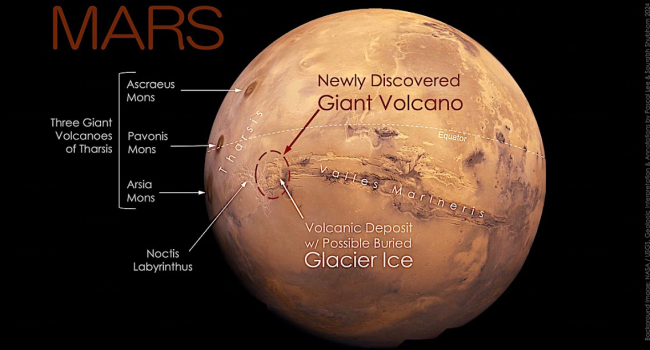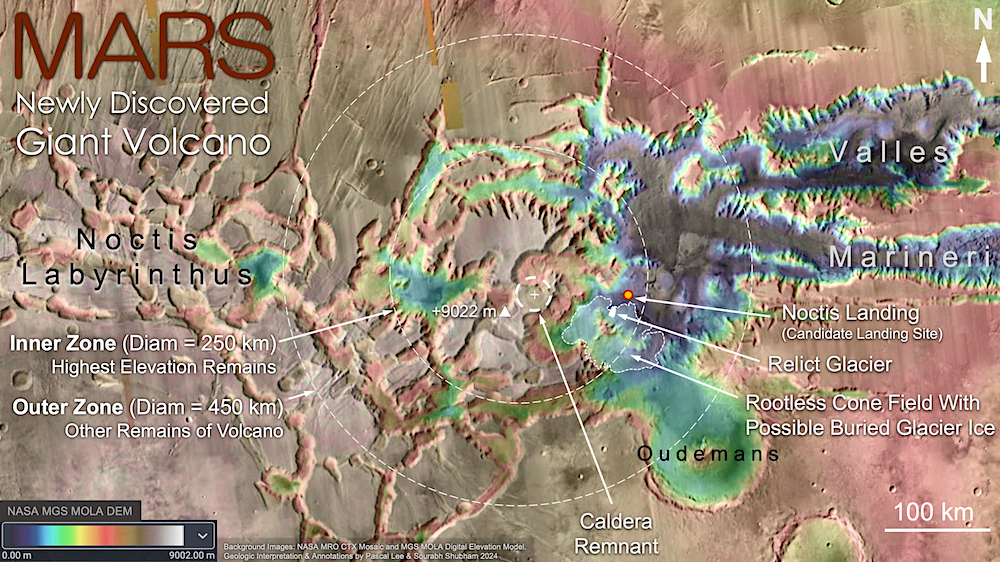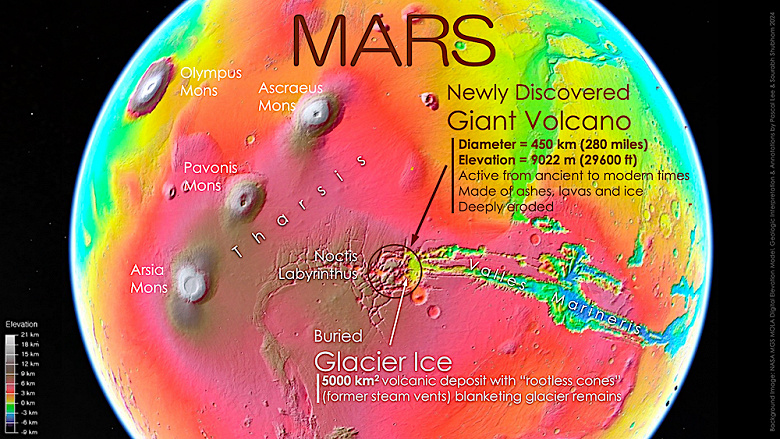
Huge new volcano 9,022 meters high and 450 kilometers wide discovered on Mars
At the 55th Conference on Lunar and Planetary Sciences (LPSC), held in The Woodlands, Texas, scientists reported the discovery of a giant volcano on Mars and a possible layer of glacial ice in the eastern part of the Martian volcanic province of Tharsis, near the planet's equator.
The giant volcano, which has repeatedly appeared in orbital spacecraft images since Mariner 9 in 1971, but has been heavily eroded over decades, has been hidden in plain sight in one of Mars' most well-known regions - at the boundary between the heavily fractured Noctis Labyrinthus labyrinth and the Valles Marineris canyon system.
This structure, temporarily named "Noctis Volcano," turned out to be an impressive formation measuring 9,022 meters in height and 450 kilometers in width. With a long history of geological changes, this volcano presents an intriguing field of study for scientists and astronomers. The giant size of the volcano and its complex history of changes indicate that it was active for a very long time. Thin layers of volcanic sediment, beneath which lies glacial ice, are found in its southeastern part. This opens up new opportunities for studying the geological evolution of Mars and searching for signs of past life.

"We have been studying the geology of the area where remnants of glaciers were found last year and realized that we are inside a huge and deeply eroded volcano," said Dr. Pascal Lee, a planetary scientist from the SETI Institute and the Mars Institute, and the lead author of the study.
Numerous signs point to the volcanic nature of this area. For example, within the structure, there are elevations forming an arc, and the outer slopes, with a gentle shape, extend for 225 kilometers. Ruins of the volcano's crater, which was once filled with a lava lake, are visible near the center of the structure. In addition, lava deposits, pyroclastic deposits (consisting of volcanic particles such as ash, ash, and pumice), and hydrated minerals are found in several areas around the volcano.
Scientists have also discovered a large area of volcanic deposits stretching over 5000 square kilometers around the volcano. These deposits consist of low, rounded, and elongated hills. They are believed to be the result of steam or vapor explosions when hot volcanic material encounters water or an icy crust on the surface.

"Noctis Volcano" has a long and complex history of changes, which is likely associated with thermal and glacial erosion. Scientists view this volcano as a massive shield composed of layered deposits of pyroclastic materials, lava, and ice, the latter accumulated as a result of multiple snowfall and glacial activities on its slopes. As cracks and fractures developed, particularly in connection with the uplift of the Tharsis region where the volcano is located, lava began to penetrate various parts of the volcano, leading to thermal erosion and the removal of a significant portion of buried ice, as well as the collapse of individual sections of the volcano.
Subsequent glacial processes continued erosion and gave the canyons inside the volcano their current characteristic shape. In this context, the "relict glacier" and the possible buried layer of glacial ice around the volcano may be remnants of the last glacial episode.
However, much remains a mystery regarding this recently discovered giant volcano. Despite knowing that it was active for a long time and began to form in the early history of Mars, there is no precise timeline for its formation. Similarly, despite eruptions being recorded, it is unknown whether it remains active and capable of erupting again. If "Noctis Volcano" was active for a very long time, it is possible that a combination of constant warmth and access to water from the underlying ice layer could have made this place conducive to life development.
- Related News
- Wheel of Death: new method will help astronauts stay fit in low gravity
- Due to anomalies of Orion spacecraft, lunar exploration program may be delayed for years։ NASA
- TAO Observatory: World's highest telescope to study evolution of galaxies and exoplanets
- Powerful M9.5 solar flare causes radio blackout in Pacific Ocean
- What will happen to the Earth if the Moon disappears?
- Key to conquering the Red Planet: Why is NASA studying solar storms on Mars?
- Most read
month
week
day
- Digital Julfa Network is launching a pan-Armenian centre in the metaverse, on the Fastexverse virtual platform 1007
- Xiaomi unveils exclusive Redmi Note 13 Pro+ dedicated to Messi and Argentina national team 891
- Sparkles: Boston Dynamics unveils a furry robot dog that can dance (video) 840
- Internet 500 times faster than 5G tested in Japan: It allows to transfer five movies in HD resolution in one second 725
- Is there a ninth planet in the solar system? Scientists find new evidence 708
- What will happen to the Earth if the Moon disappears? 701
- iPhone 16 may get colored matte glass back panel, 7 colors 678
- How to understand how protected a smartphone is from water and dust? 670
- World's largest 3D printer was created in USL It prints 29 meter-long structures 658
- Which smartphones will be the first to receive Android 15? 648
- Archive
